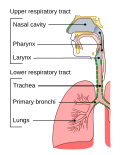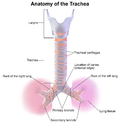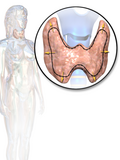Trachea
Trachea[edit]
The trachea, commonly known as the windpipe, is a vital part of the respiratory system in humans and many other animals. It is a tube that connects the larynx to the bronchi of the lungs, allowing the passage of air. The trachea is an essential component of the body's airway and plays a crucial role in respiration.
Structure[edit]
The trachea is approximately 10 to 12 centimeters long and 2 centimeters in diameter in adults. It is composed of 16 to 20 C-shaped rings of hyaline cartilage that provide structural support and maintain an open airway. The open part of the C-shaped rings faces posteriorly, towards the esophagus, allowing the trachea to expand slightly during swallowing.
The inner lining of the trachea is made up of ciliated pseudostratified columnar epithelium, which contains goblet cells that secrete mucus. This mucus traps inhaled particles, and the cilia move the mucus upwards towards the pharynx where it can be swallowed or expelled.
Function[edit]
The primary function of the trachea is to provide a clear airway for air to enter and exit the lungs. It also helps to warm, moisten, and filter the air before it reaches the lungs. The trachea's cilia and mucus play a critical role in trapping and expelling foreign particles and pathogens.
Clinical significance[edit]
The trachea can be affected by various medical conditions, including:
- Tracheitis: Inflammation of the trachea, often due to infection.
- Tracheal stenosis: Narrowing of the trachea, which can be congenital or acquired.
- Tracheomalacia: Weakness of the tracheal walls, leading to collapse during breathing.
- Tracheoesophageal fistula: An abnormal connection between the trachea and the esophagus.
Related pages[edit]
Gallery[edit]
-
Diagram of the conducting passages of the respiratory system.
-
Anatomy of the trachea.
-
CT scan of the thorax.
-
Standard chest CT scan.
-
Chest CT scan showing the mediastinum.
-
Cross-section of the trachea and esophagus.
-
Sternohyoid muscle related to the trachea.
-
Goiter affecting the trachea.
-
Gray's anatomy illustration of the trachea.
-
Another Gray's anatomy illustration.
-
Detailed image of the trachea.
-
Tracheal cartilage.
-
Audio of stridor, a sound associated with tracheal obstruction.
-
Tracheal diverticulum.
-
Tracheal system in a cockroach.
-
Tracheae in a cockroach.
-
Histology of a mammalian trachea.
-
Low magnification histology of a mammalian trachea.
-
Detailed image of the larynx.
-
Gray's anatomy illustration of the larynx and trachea.
-
3D model of the trachea.
Ad. Transform your life with W8MD's Budget GLP-1 injections from $75


W8MD offers a medical weight loss program to lose weight in Philadelphia. Our physician-supervised medical weight loss provides:
- Weight loss injections in NYC (generic and brand names):
- Zepbound / Mounjaro, Wegovy / Ozempic, Saxenda
- Most insurances accepted or discounted self-pay rates. We will obtain insurance prior authorizations if needed.
- Generic GLP1 weight loss injections from $75 for the starting dose.
- Also offer prescription weight loss medications including Phentermine, Qsymia, Diethylpropion, Contrave etc.
NYC weight loss doctor appointmentsNYC weight loss doctor appointments
Start your NYC weight loss journey today at our NYC medical weight loss and Philadelphia medical weight loss clinics.
- Call 718-946-5500 to lose weight in NYC or for medical weight loss in Philadelphia 215-676-2334.
- Tags:NYC medical weight loss, Philadelphia lose weight Zepbound NYC, Budget GLP1 weight loss injections, Wegovy Philadelphia, Wegovy NYC, Philadelphia medical weight loss, Brookly weight loss and Wegovy NYC
|
WikiMD's Wellness Encyclopedia |
| Let Food Be Thy Medicine Medicine Thy Food - Hippocrates |
Medical Disclaimer: WikiMD is not a substitute for professional medical advice. The information on WikiMD is provided as an information resource only, may be incorrect, outdated or misleading, and is not to be used or relied on for any diagnostic or treatment purposes. Please consult your health care provider before making any healthcare decisions or for guidance about a specific medical condition. WikiMD expressly disclaims responsibility, and shall have no liability, for any damages, loss, injury, or liability whatsoever suffered as a result of your reliance on the information contained in this site. By visiting this site you agree to the foregoing terms and conditions, which may from time to time be changed or supplemented by WikiMD. If you do not agree to the foregoing terms and conditions, you should not enter or use this site. See full disclaimer.
Credits:Most images are courtesy of Wikimedia commons, and templates, categories Wikipedia, licensed under CC BY SA or similar.
Translate this page: - East Asian
中文,
日本,
한국어,
South Asian
हिन्दी,
தமிழ்,
తెలుగు,
Urdu,
ಕನ್ನಡ,
Southeast Asian
Indonesian,
Vietnamese,
Thai,
မြန်မာဘာသာ,
বাংলা
European
español,
Deutsch,
français,
Greek,
português do Brasil,
polski,
română,
русский,
Nederlands,
norsk,
svenska,
suomi,
Italian
Middle Eastern & African
عربى,
Turkish,
Persian,
Hebrew,
Afrikaans,
isiZulu,
Kiswahili,
Other
Bulgarian,
Hungarian,
Czech,
Swedish,
മലയാളം,
मराठी,
ਪੰਜਾਬੀ,
ગુજરાતી,
Portuguese,
Ukrainian















